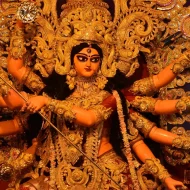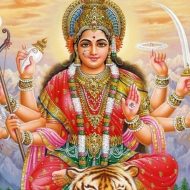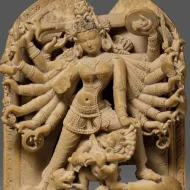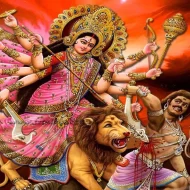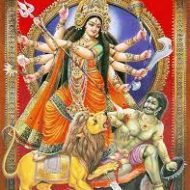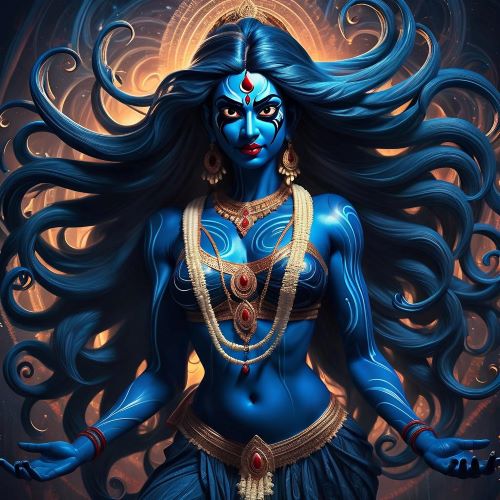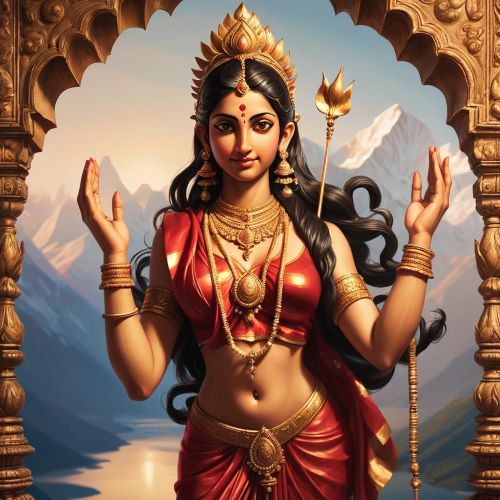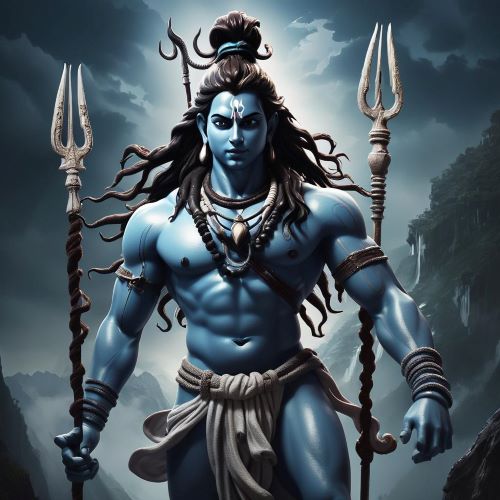Durga : The Divine Mother
Listen
At a glance
| Description | |
|---|---|
| Origin | Indian Mythology |
| Classification | Gods |
| Family Members | N/A |
| Region | India |
| Associated With | Protection, Destruction |
Durga
Introduction
In Hinduism, Durga, also known as Devi and Shakti, is a prominent manifestation of the Goddess. Her name, “Durga,” translates to “the Inaccessible” in Sanskrit. According to Hindu legend, Durga was brought into existence by Brahma, Vishnu, Shiva, and other lesser deities to vanquish the formidable buffalo demon Mahishasura, who proved impervious to their individual efforts. She embodies the combined energy, known as “shakti,” of these male divinities and is both an extension of their power and its ultimate source. Durga transcends the individual gods in terms of her might. The annual Durga Puja, a grand festival celebrated in northeastern India, is dedicated to honoring her divine presence.
The most significant scriptures in Shaktism, namely the Devi Mahatmya and Devi Bhagavata Purana, hold Devi (the Goddess) in the highest reverence as the original creator of the universe and the embodiment of Brahman, signifying the ultimate truth and reality. Within the Smarta tradition of Hinduism, she is counted among the five equal deities in the practice of Panchayatana puja. Devotees predominantly venerate Durga during the seasons of spring and autumn, particularly during the celebrations of Durga Puja, Durga Ashtami, Vijayadashami, Deepavali, and Navaratri.
Physical Traits
Durga is often depicted as a fully grown and beautiful deity, radiating a fierce and menacing aura when confronting her adversaries. She is typically portrayed riding a lion and possesses eight or ten arms, each holding a unique weapon granted to her by the gods, who bestowed these tools upon her for the battle against the buffalo demon.
In her typical depictions, Durga embodies several key attributes. She is often seen mounted on a lion or tiger, with between eight and eighteen arms, each grasping a weapon capable of both destruction and creation. Her iconography frequently portrays her in the midst of battle with Mahishasura, the buffalo demon, capturing the moment of her triumphant victory. Despite the intensity of these scenes, Durga’s visage remains tranquil and serene.
Traditionally, Durga wields an array of weapons from the male gods of Hindu mythology, who bestow them upon her to combat malevolent forces. These weapons include the chakra, conch, bow, arrow, sword, javelin, trishula (trident), shield, and a noose. For Shakta Hindus, these weapons hold symbolic meanings, representing self-discipline, selfless service, self-reflection, prayer, devotion, mantra recitation, joyfulness, and meditation. Durga herself is seen as the inner “Self” and the divine mother of all creation. Warriors have sought her blessings for their weapons.
Family
Throughout the story, Durga appears in Her many great manifestations as Parvati, Ambika, Mahalakshmi, Chandika and others. She takes various divine forms to engage in each battle and meet whatever threatening egoic energies appear. In Hinduism, it’s a common belief that the major gods and goddesses can take on multiple incarnations, allowing them to manifest on Earth as various other deities. Durga is no exception to this concept, and among her numerous avatars, we find Kali, Bhagvati, Bhavani, Ambika, Lalita, Gauri, Kandalini, Java, and Rajeswari.
When Durga appears in her original form, she reveals herself in one of nine distinct appellations or forms: Skondamata, Kusumanda, Shailaputri, Kaalratri, Brahmacharini, Maha Gauri, Katyayani, Chandraghanta, and Siddhidatri. Together, these manifestations are known as the Navadurga. Each of these deities has their own dedicated holidays in the Hindu calendar, as well as special prayers and hymns of adoration associated with them.
Other names
In Sanskrit, the term “Durga” carries the meaning of “a fortress” or “a stronghold that is challenging to conquer,” serving as a fitting metaphor for the protective and warrior-like essence of this deity. Durga is occasionally addressed as “Durgatinashini,” a name that directly signifies “the eliminator of suffering.”
Powers and Abilities
Durga wields an array of symbolic weapons and items in her battle against evil, each carrying profound significance within Hinduism. Here are the most significant of these symbols. The conch shell represents the Pranava, symbolizing the mystic sound “Om.” It signifies Durga’s connection to the divine through sound. Durga’s holding of the bow and arrows in one hand signifies her mastery over both potential and kinetic energy, emphasizing control over these forces. The thunderbolt symbolizes unwavering conviction. Just as a real lightning bolt can destroy anything in its path, Durga encourages Hindus to confront challenges with unshakable confidence. The partially blooming lotus in Durga’s hand represents the assurance of success while acknowledging that it’s not the final destination. It reminds the faithful to stay committed to their spiritual journey amidst worldly distractions.
This beautiful discus spinning around Durga’s index finger signifies her complete command over the world. She uses it to eliminate evil and Durga’s sword symbolizes knowledge, which possesses the sharpness of a blade. It represents clear, doubt-free understanding. The trident represents three qualities: Satwa (inactivity), Rajas (activity), and Tamas (nonactivity). Durga uses these to alleviate physical, mental, and spiritual suffering.
Durga is often depicted in Hindu art and iconography standing atop or riding a tiger or lion. This choice signifies power, will, and determination. Her confident posture, known as Abhay Mudra or “freedom from fear,” underscores her fearless confrontation of evil. In this portrayal, Durga serves as a role model, encouraging Hindu devotees to lead their lives with righteousness and courage, confronting challenges without fear, just as the mother goddess does.
Modern Day Influence
The Hindu calendar boasts an abundance of holidays and festivals, owing to its myriad deities. Among these, Durga, one of the faith’s most revered goddesses, enjoys multiple celebrations throughout the year. The most prominent of these is Durga Puja, a four-day festival observed in September or October, depending on the Hindu lunisolar calendar. During Durga Puja, devotees commemorate her triumph over evil through special prayers, readings, ornate temple and home decorations, and dramatic retellings of Durga’s legend.
Archaeological excavations in Indonesia, notably on the island of Java, have unearthed a wealth of Durga statues dating from the 6th century onward. Among the numerous stone sculptures of Hindu deities discovered in the Indonesian islands, over 135 are representations of Durga. In certain regions of Java, she is known as Loro Jonggrang, which translates to “slender maiden.”
In Cambodia, during its era of Hindu monarchs, Durga enjoyed popularity, and numerous sculptures depicting her have been uncovered. However, a notable distinction exists in Cambodian Durga iconography: she is depicted standing atop the severed head of the buffalo demon. Additionally, Durga statues have been found at stone temples and archaeological sites in Vietnam, likely associated with the Champa or Cham dynasty era.
Related Images
Frequently Asked Questions
What is lorem Ipsum?
I am text block. Click edit button to change this text. Lorem ipsum dolor sit amet, consectetur adipiscing elit. Ut elit tellus, luctus nec ullamcorper mattis, pulvinar dapibus leo.
What is lorem Ipsum?
I am text block. Click edit button to change this text. Lorem ipsum dolor sit amet, consectetur adipiscing elit. Ut elit tellus, luctus nec ullamcorper mattis, pulvinar dapibus leo.
What is lorem Ipsum?
I am text block. Click edit button to change this text. Lorem ipsum dolor sit amet, consectetur adipiscing elit. Ut elit tellus, luctus nec ullamcorper mattis, pulvinar dapibus leo.
What is lorem Ipsum?
I am text block. Click edit button to change this text. Lorem ipsum dolor sit amet, consectetur adipiscing elit. Ut elit tellus, luctus nec ullamcorper mattis, pulvinar dapibus leo.
What is lorem Ipsum?
I am text block. Click edit button to change this text. Lorem ipsum dolor sit amet, consectetur adipiscing elit. Ut elit tellus, luctus nec ullamcorper mattis, pulvinar dapibus leo.

